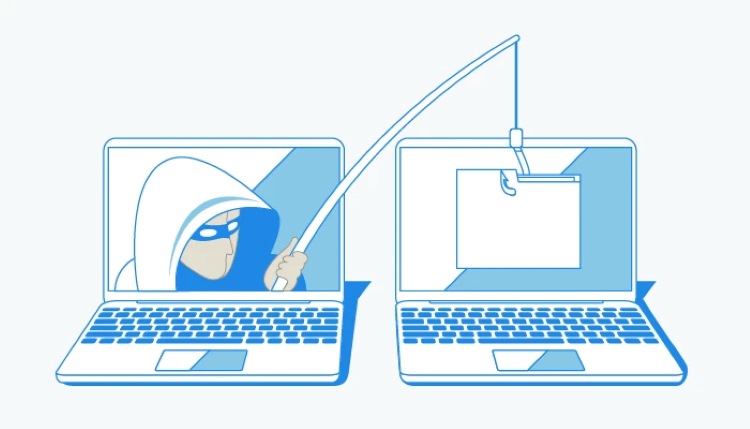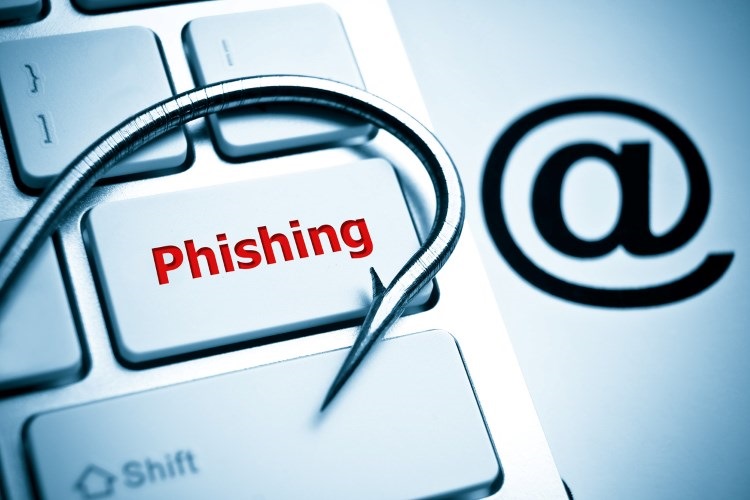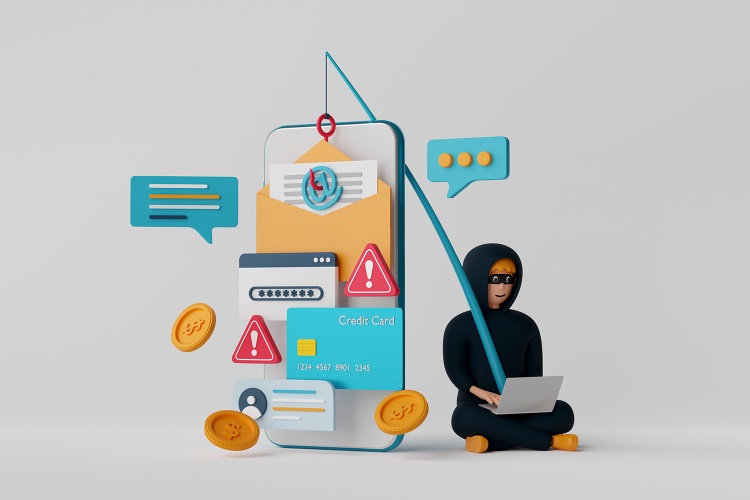Ever received a weird email asking for your password or a text message urging you to click a link immediately? You might have encountered phishing. But what exactly is phishing, and why is it so important to understand? This guide will clearly explain phishing scams, show you how they work, teach you how to recognize the warning signs, and provide simple tips to help you stay safe online and protect your sensitive information.
What Exactly is Phishing?
Phishing is a type of online scam where criminals trick you into giving them sensitive information. They pretend to be legitimate companies or people to steal things like passwords, bank account numbers, credit card details, or social security numbers.
Think of it like actual fishing. Scammers “bait” a hook with a fake message (the lure) and cast it out via email, text message, or phone call, hoping someone will “bite” by clicking a malicious link or revealing personal data. Their ultimate goal is usually financial gain or access to your accounts, which can lead to identity theft. This is a common form of cybercrime affecting millions globally.

How Do Phishing Scams Actually Work?
Phishing scams work by exploiting human psychology through social engineering and deceptive communication. Social engineering is the art of manipulating people into performing actions or divulging confidential information. Phishers use this to bypass technical security measures by targeting the human element.
Here’s a typical step-by-step process:
- The Setup: A scammer creates a fake message (email, text, social media post) or a fake website. This communication is designed to look like it comes from a trusted source – perhaps your bank, a popular online store, a government agency, or even a colleague.
- The Lure: The message often creates a sense of urgency, fear, or curiosity. It might claim your account has been compromised, you’ve won a prize, there’s a problem with an order, or you need to verify information immediately.
- The Hook: The message usually contains a call to action – typically asking you to click a link, download an attachment, or reply with sensitive information.
- The Catch:
- If you click a malicious link, it might take you to a fake login page that looks identical to the real one. When you enter your username and password, the scammer captures it.
- Alternatively, the link might lead to a website that automatically downloads malware (malicious software like viruses or ransomware) onto your device.
- Opening a malicious attachment can also install malware.
- Replying with requested information delivers it directly to the scammer.
- The Result: Once scammers have your information, they can use it to log into your accounts, steal money, make fraudulent purchases, or sell your data on the dark web, potentially leading to identity theft.
The key is deception. Phishers rely on mimicking trusted entities convincingly enough to trick people into letting their guard down for just a moment.
Common Types of Phishing Attacks You Might Encounter
Phishing isn’t a single technique; scammers use various methods to target potential victims. Understanding these common types helps you stay vigilant:
Email Phishing (Most Common)
This is the classic form. Scammers send out massive numbers of fraudulent emails, hoping a percentage of recipients will fall for the trap. These emails often look like they’re from banks, credit card companies, online retailers, or social media sites.
Example: An email appearing to be from PayPal states there’s unusual activity on your account. It urges you to click a link immediately to verify your identity. The link leads to a fake PayPal login page designed to steal your credentials.
Spear Phishing (Targeted Attacks)
Unlike broad email phishing, spear phishing targets specific individuals or organizations. The scammers research their targets (often using social media or company websites) to personalize the attack, making it seem more legitimate and harder to detect.
Example: An employee receives an email seemingly from their company’s IT department. The email mentions a recent software update and asks the employee to log in via a provided link using their corporate credentials to complete the process. The email might use the employee’s name and reference specific company projects.
Whaling (Targeting Executives)
Whaling is a type of spear phishing specifically aimed at high-profile targets within an organization, such as CEOs, CFOs, or other senior executives (the “big fish”). These attacks are often highly sophisticated and aim for high-value information or financial authorization.
Example: A company CFO receives an email that looks like it’s from the CEO, requesting an urgent wire transfer to a specific account for a confidential acquisition. The scammer spoofs the CEO’s email address and uses language consistent with previous communications.
Smishing (SMS/Text Message Phishing)
Smishing uses text messages (SMS – Short Message Service) instead of email. These messages often contain urgent alerts or tempting offers with a link to click. Because people tend to trust text messages more than emails, smishing can be particularly effective.
Example: You receive a text message claiming to be from your mobile carrier, stating you’ve overpaid your bill and are due a refund. It provides a link to claim the refund, which leads to a site asking for your bank details or login credentials. Another common example involves fake package delivery notifications asking for a small fee via a malicious link.
Vishing (Voice/Phone Call Phishing)
Vishing involves phishing over the phone (voice calls). Scammers might call pretending to be from tech support, your bank’s fraud department, the IRS, or even law enforcement. They use social engineering tactics to persuade you to reveal information or grant remote access to your computer.
- Example: You get a call from someone claiming to be from Microsoft Tech Support. They state your computer has been flagged for sending out viruses. They ask you to grant them remote access to “fix” the problem, which allows them to install malware or steal files. Another tactic involves callers pretending to be from your bank, asking you to “verify” your account details due to suspicious activity.

How to Recognize a Phishing Attempt: Key Red Flags
While scammers are getting better at creating convincing fakes, there are usually warning signs. Training yourself to spot these phishing red flags is crucial for online safety:
- Suspicious Sender Address: Look closely at the sender’s email address. Phishers often use addresses that are slightly misspelled versions of legitimate ones (e.g.,
service@paypaI.comwith a capital ‘i’ instead of ‘l’) or use public domains (like @gmail.com) for official business communications. - Generic Greetings: Legitimate companies you do business with usually address you by name. Be wary of generic greetings like “Dear Valued Customer,” “Sir/Madam,” or just “Hello.”
- Urgent Calls to Action or Threats: Phishing messages often try to rush you. Phrases like “Urgent Action Required,” “Account Suspension Warning,” or “Your account will be closed” are common tactics to provoke immediate reaction without thinking.
- Requests for Sensitive Information: Legitimate organizations rarely ask for passwords, PINs, Social Security numbers, or full bank account details via email or text. Be extremely suspicious of any unsolicited message asking for this.
- Poor Grammar and Spelling Errors: While some phishing attempts are sophisticated, many still contain noticeable spelling mistakes, awkward phrasing, or grammatical errors. Professional organizations usually proofread their communications carefully.
- Mismatched Links (Hover to Check): Always hover your mouse cursor over links in emails before clicking. The destination URL (Uniform Resource Locator, the web address) often appears in a small pop-up or at the bottom of your browser window. If the displayed URL looks different from the link text or seems suspicious (e.g., points to a completely different domain), do not click it.
- Example: The link text might say
www.mybank.com/login, but hovering reveals the actual URL iswww.totallynotascam-mybank.ru/login.
- Example: The link text might say
- Unexpected Attachments: Be cautious of attachments you weren’t expecting, especially from unknown senders. These files can contain malware. Common malicious file types include .zip, .exe, .scr, or even specially crafted Office documents (.doc, .xls, .pdf).
- Too-Good-To-Be-True Offers: Messages offering unbelievable prizes, lottery winnings, or investment returns are almost always scams. If it sounds too good to be true, it probably is.
Trust your instincts. If a message feels off or suspicious, it’s best to err on the side of caution.
What are the Dangers? Why Phishing is a Serious Threat
Falling victim to a phishing attack can have serious consequences, making it a significant threat in the digital world. Because phishing targets sensitive information, it falls under Google’s YMYL (Your Money or Your Life) category, meaning content about it must be especially accurate and trustworthy (reflecting strong E-E-A-T: Experience, Expertise, Authoritativeness, Trustworthiness).
Potential dangers include:
- Financial Loss: Scammers can drain your bank account, make unauthorized credit card purchases, or take out loans in your name. Phishing is a primary method used in online fraud.
- Identity Theft: With enough personal information (like your name, address, date of birth, Social Security number), criminals can steal your identity to open new accounts, file fraudulent tax returns, or commit other crimes in your name.
- Malware Infections: Clicking malicious links or opening attachments can install viruses, spyware, ransomware, or other malware on your device. This can lead to data loss, device damage, or further information theft. Ransomware, for instance, encrypts your files and demands payment for their release.
- Compromised Accounts: Stolen login credentials give attackers access to your email, social media, cloud storage, or other online accounts. They can lock you out, impersonate you, scam your contacts, or access further private information.
- Damage to Reputation (Personal and Professional): If your email or social media account is compromised, attackers might send malicious messages to your contacts, damaging your relationships or professional reputation. For businesses, a successful phishing attack on an employee can lead to major data breaches and reputational harm.
The impact of phishing extends beyond immediate financial loss, potentially causing long-term stress and difficulty in recovering compromised accounts and identity.
What Should I Do If I Suspect Phishing (or Clicked a Link)?
Reacting quickly and correctly if you suspect phishing or realize you’ve made a mistake is vital. Here are the recommended steps:
If You Suspect a Message is Phishing (But Haven’t Clicked/Replied):
- Do NOT Click Any Links or Open Attachments: This is the most crucial step. Avoid interacting with the message content.
- Do NOT Reply: Replying confirms your email address is active and might invite more scam attempts.
- Report the Message: Use the “Report Phishing” or “Report Junk” option in your email client (like Gmail or Outlook). You can also forward phishing emails to organizations like the Anti-Phishing Working Group (APWG) at
reportphishing@apwg.orgor report them directly to the company being impersonated (use their official website contact info, not info from the suspicious message). Report smishing texts to your carrier (often by forwarding to 7726 – SPAM). - Delete the Message: After reporting, safely delete the phishing email or text.
If You Clicked a Link, Opened an Attachment, or Provided Information:
- Disconnect from the Internet: If you suspect malware was downloaded, disconnecting your device can prevent it from spreading or communicating with the attacker.
- Change Your Passwords IMMEDIATELY: If you entered login credentials on a fake site, change the password for that account right away. Crucially, also change the password on ANY other account where you use the same or a similar password. Use strong, unique passwords for every account.
- Run a Full Security Scan: Use reputable antivirus and anti-malware software to scan your device thoroughly. Remove any threats found.
- Contact Your Bank or Credit Card Company: If you revealed financial information, contact your bank or credit card issuer immediately. Explain the situation, monitor your statements closely for unauthorized transactions, and consider placing a fraud alert on your credit reports.
- Enable Two-Factor Authentication (2FA) / Multi-Factor Authentication (MFA): 2FA/MFA adds an extra layer of security by requiring a second form of verification (like a code sent to your phone) in addition to your password. Enable this wherever possible, especially on important accounts like email and banking.
- Monitor Your Accounts: Keep a close eye on your email, bank, credit card, and other online accounts for any suspicious activity.
- Report the Incident: Report the identity theft to relevant authorities if applicable (e.g., the Federal Trade Commission (FTC) in the US via
IdentityTheft.gov).
Taking these steps promptly can significantly limit the damage caused by a phishing attack.

Staying Safe: Tips to Protect Yourself from Phishing
While phishing attacks are common, you can significantly reduce your risk by adopting safe online habits and using available security tools. Prevention is key:
- Be Skeptical: Treat unsolicited emails, texts, and calls with caution, especially those asking for personal information or urging immediate action. Don’t automatically trust messages just because they look official.
- Verify Requests Independently: If an email or call asks you to take action (like verifying account details), don’t use the contact information or links provided in the message. Instead, go directly to the company’s official website by typing the address into your browser or use a known, trusted phone number to contact them and verify the request.
- Secure Your Accounts:
- Use strong, unique passwords for all your online accounts. Consider using a password manager to help create and store complex passwords.
- Enable Two-Factor Authentication (2FA) or Multi-Factor Authentication (MFA) whenever offered. This is one of the most effective ways to protect your accounts even if your password is stolen.
- Keep Software Updated: Regularly update your operating system (Windows, macOS), web browser, and security software (antivirus/anti-malware). Updates often include patches for security vulnerabilities that phishers exploit.
- Hover Before You Click: Always check where a link is going before you click it by hovering your mouse over it. Pay attention to the domain name in the URL.
- Look for HTTPS: When entering sensitive information online, ensure the website address starts with
https://(not justhttp://) and displays a padlock icon in the browser bar. This indicates a secure, encrypted connection, though scammers can sometimes obtain these certificates too, so it’s not foolproof on its own. - Be Cautious on Public Wi-Fi: Avoid accessing sensitive accounts (like online banking) or entering personal information when connected to unsecured public Wi-Fi networks, as data can sometimes be intercepted.
- Educate Yourself and Others: Stay informed about the latest phishing techniques. Share your knowledge with friends, family, and colleagues – phishing awareness is a collective defense. Many organizations now conduct phishing simulation exercises to train employees.
No single tip is foolproof, but combining these practices creates multiple layers of defense against phishing attacks.
Conclusion: Be Aware, Stay Secure
Phishing is a persistent and evolving online threat designed to trick you into revealing sensitive information through deceptive communication. It relies on impersonation and social engineering, manifesting in various forms like emails, text messages (smishing), and voice calls (vishing).
Understanding what phishing is, how it works, and the common red flags is your first line of defense. Always be skeptical of unsolicited requests for information, verify communications independently, and protect your accounts with strong passwords and two-factor authentication. By staying vigilant and practicing safe online habits, you can significantly reduce your risk of becoming a victim and navigate the digital world more securely. Remember, online security starts with awareness.
